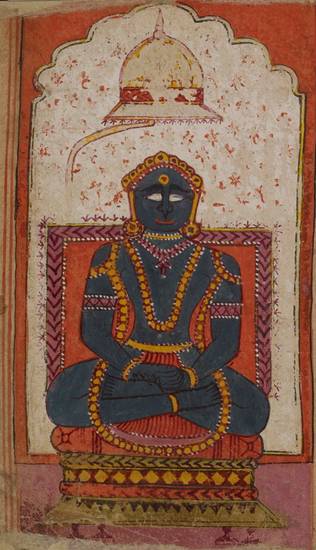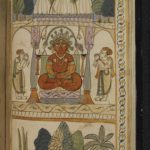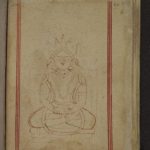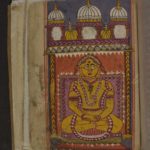Article: Emblems of the 24 Jinas
The 24 Jinas that appear in each cycle of time are always represented in a very stylised way in artwork. Therefore pictures and statues of individual Jinas are very hard to identify because they appear identical.
Each Jina has an emblem that is frequently included in pictures or sculptures so he can be recognised. This is referred to by the Sanskrit word lāñchana. This convention does not seem to have been known in early Jainism, so perhaps it was influenced by the Hindu environment, where each god has an identifying vehicle or emblem.
Identifying Jinas
In works of art Jinas are usually very hard to tell apart because they are depicted in a very idealised style. Thus the individual emblems are crucial to identifying a Jina.
Even so, one Jina is easy to recognise. The 23rd Jina, Pārsvanātha or Lord Pārsva, is usually depicted wearing a snake-hood. The number of snake-hoods he wears varies between seven and nine, although seven is the most common number.
There are also specific identifying signs for the first Jina, Ṛṣabhanātha or Lord Ṛṣabha, and the seventh one, Supārśvanātha or Lord Supārśva. Ṛṣabha has long locks of hair falling on his shoulders while Supārśva has snake-hoods above the head, smaller than those of Pārsva.
Mallinātha or Lord Malli, the 19th Jina, is problematic, because she is considered to be a woman in the Śvetāmbara tradition.
In addition, sometimes a Jina’s body is painted in his individual colour, which can help in identifying him. Some variations are due to the fact that the Indian word nīla refers to ‘dark’, which can mean dark blue or black, or sometimes even green.
Typical representations of Jinas
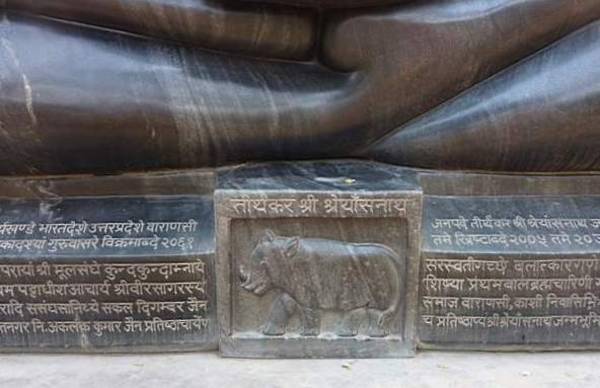
Emblem of Śreyāṃsa
Image by Nalini Balbir © Nalini Balbir
A Jina is always shown in meditation in one of two positions. He commonly stands in the kāyotsarga posture of ‘rejection of the body’, which indicates that he is so deep in meditation he is indifferent to his surroundings. The other main meditation pose in which Jinas are shown is the lotus position.
A Jina in art may also have a kind of tilaka on his forehead and an endless knot on his chest.
Among the Śvetāmbaras, the Jina is thought of as a spiritual king and is often depicted with ornaments and pictured seated on a throne. Otherwise he wears only a loincloth or perhaps the simple white robe of a monk.
In the Digambara Jain tradition, the Jinas are always represented entirely naked and without any ornamentation.
There are also small differences in the emblem of a Jina between the two sects. The emblem of an individual Jina can usually be seen on the cloth on which he sits, on the foot of his throne or in a corner of the pedestal on which he stands. It is commonly quite small.
|
Jina |
Colour |
Śvetāmbara emblem |
Digambara emblem |
|
|---|---|---|---|---|
|
1 |
Ṛṣabha |
gold |
bull |
bull |
|
2 |
gold |
elephant |
elephant |
|
|
3 |
gold |
horse |
horse |
|
|
4 |
gold |
monkey |
monkey |
|
|
5 |
gold |
crane – krauñca-bird |
crane – krauñca– or koka-bird |
|
|
6 |
red |
red lotus |
red lotus |
|
|
7 |
Supārśva |
gold or emerald |
labyrinth – nandyāvarta – or svastika |
|
|
8 |
white |
|||
|
9 |
white |
crocodile – makara |
crocodile or crab |
|
|
10 |
gold |
endless knot – śrīvatsa |
endless knot or wishing-tree – kalpavṛkṣa |
|
|
11 |
Śreyāṃsa |
gold |
rhinoceros |
rhinoceros |
|
12 |
red |
buffalo |
buffalo |
|
|
13 |
gold |
boar |
boar |
|
|
14 |
gold |
falcon |
bear |
|
|
15 |
gold |
thunderbolt – vajra |
thunderbolt – vajra |
|
|
16 |
gold |
deer |
deer |
|
|
17 |
gold |
goat |
goat |
|
|
18 |
gold |
labyrinth – nandyāvarta |
fish, flower |
|
|
19 |
blue |
water pot – kalaśa |
water pot – kalaśa |
|
|
20 |
black |
tortoise |
tortoise |
|
|
21 |
black, yellow or emerald |
blue lotus |
blue lotus |
|
|
22 |
blue or black |
conch |
||
|
23 |
green |
snake – cobra |
snake – cobra |
|
|
24 |
yellow |
lion |
Adapted from the table ‘Tirthankaras’ Cognizances’ on page 247, Appendix of Historical Dictionary of Jainism. Kristi L. Wiley. The Scarecrow Press, Inc.. Lanham, Maryland. 2004.
In art the emblems do not appear before the 5th century CE. In texts the full lists are even later, showing that there might have been a considerable gap between this concept’s starting to appear and the time it was codified. The standard list of the Śvetāmbaras is found in the Abhidhānacintāmaṇi, a dictionary of synonyms written by Hemacandra in the 12th century. The Digambaras often refer to the list in the Tiloyapannatti, one of their treatises on the Jain universe written in Prakrit. They give the fairly early date of the 6th century to this work, but this is a matter of controversy.
Links
- A Jina sits in meditation
-
The National Gallery of Australia provides this 12th-century image of a seated Jina. Under an ornate arch, the Jina takes the lotus pose of meditation. He is hard to identify without his emblem – lāñchana – but his closed eyes, unadorned figure and nudity indicate the statue was produced by the Digambara sect.
http://artsearch.nga.gov.au/Detail-LRG.cfm?IRN=128702&View=LRG
- Svetāmbara Jina emblems
-
This picture from the Jeevraksha blog gives the emblems – lāñchana – of the 24 Jinas according to the Svetāmbara sect.
http://2.bp.blogspot.com/_xHZFB-N3uug/TNNW_DqmmeI/AAAAAAAAAzw/v43mxT0R1RY/s1600/jain_symbols2.jpg
- Jina images and temples at Gwalior
-
The pilgrimage centre of Gwalior in central India is famous for its carvings of Jinas. Both freestanding and relief sculptures, the Jinas are found in the temples as well as in panels cut into walls of rock. This collection of drawings and photographs is presented by Professor Frances W. Pritchett of Columbia University in New York.
http://www.columbia.edu/itc/mealac/pritchett/00routesdata/1000_1099/jaintemples/gwalior/gwalior.html
- Statue of a meditating Jina
-
This idol of a Jina shows him in the characteristic lotus position of meditation. He has a serene half-smile on his face, elongated earlobes and curly hair. The severe style and lack of clothing indicates that the 11th-century statue belongs to the sect of the Digambaras. It may depict the 24th Jina, Mahāvīra. The photograph provided by the Philadelphia Museum of Art is accompanied by a brief audio commentary on the statue.
http://www.philamuseum.org/collections/permanent/64704.html?mulR=10908|7
- Anointing a Jina statue
-
A statue of a Jina is ceremonially anointed during the festival of Dīvālī, the 'Festival of Lights' which marks the new year. For Jains the main celebration at Dīvālī is the commemoration of the liberation of the 24th Jina, Mahāvīra. A ‘head-anointing ceremony’ – mastakābhiṣeka – is a rite performed for any Jain image. Sanctified fluids are poured over the head of the statue, accompanied by a mantra or hymn. The sacred bath is at the centre of all Jain image rituals and can be performed daily in the morning ceremony or during festivals and pilgrimages. This photo on Flickr was taken in Jodhpur, Rajasthan in October 2009.
- Pārśva meditating
-
The National Gallery of Australia offers an elaborately illustrated page from a 15th-century manuscript of the Kalpa-sūtra. The 23rd Jina Pārśva sits in the lotus posture of meditation. He is easily identifiable from his seven-headed snake headdress.
http://artsearch.nga.gov.au/Detail-LRG.cfm?IRN=177853&View=LRG
- Images of Jinas
-
A few photographs of Jina images in various styles, ranging from tenth-century sculptures to a contemporary depiction, provided by Professor Frances W. Pritchett of Columbia University in New York.
- +
- aAbhavya
- aAbhinandana
- aAbhiṣeka
- aĀcāra
- aĀcārāṅga-sūtra
- aĀcārya
- aAchalbhrata
- aAḍhāī-dvīpa
- aAdharma
- aAdho-loka
- aAdhyayana
- aAdvaita Vedānta
- aĀgama
- aAghātīya
- aAghātīya-karman
- aAgnibhuti
- aAgra
- aĀhāra
- aAhiṃsā
- aAhimsa Day
- aAjita
- aAjīva
- aAkampit
- aĀkāśa
- aAkbar the Great
- aAkṣaya-tṛtīyā
- aAlauddin Khalji
- aAlbert Einstein
- aAllah
- aAlms
- aĀlocanā
- aAloka-ākāśa
- aAmāri
- aAmbikā or Kūṣmāṇḍinī
- aAnagāra
- aAnanta
- aAnarthadaṇḍa
- aAnaśana
- aAnekānta-vāda
- aAṅga
- aAniconism
- aAnojjā
- aAntarāla
- aAntarāya-karma
- aAṇu
- aAṇu-vrata
- aAnukampā
- aAnuprekṣā
- aAnusvāra
- aApabhraṃśa
- aAparigraha
- aAra
- aĀrambha
- aĀrambhaja
- aĀratī
- aArdhamāgadhī Prākrit
- aArhaṃ
- aArhat
- aArśana-āvaraṇīya-karma
- aĀrta-dhyāna
- aĀryikā
- aĀryikā Jñānamati
- aĀśātanā
- aĀścarya
- aAscetic
- aAsceticism
- aAshram
- aAspiration
- aĀsrava
- aAṣṭa-maṅgala
- aAṣṭāpada
- aAstikāya
- aAstrolabe
- aAsura
- aAtheism
- aAticāra
- aAtiśayakṣetra
- aAtithisaṃvibhāgavrata
- aĀtma-vāda
- aĀtman
- aAuṃ
- aAurangzeb
- aAuspicious
- aAusterity
- aAvadhāna
- aAvadhi-jñāna
- aĀvaraṇī-yakarman
- aAvasarpiṇī
- aAvatāra
- aAvidyā
- aAxiom
- aĀyāga-paṭa
- aĀyambil
- aĀyu-karma
- aĀyurveda
- bBabur
- bBāhubali
- bBaladeva
- bBālāvabodha
- bBandha
- bBasadi
- bBazaar
- bBhadrankarvijay
- bBhagavant
- bBhaktāmara-stotra
- bBhakti
- bBhale
- bBharata
- bBhāṣā
- bBhāṣya
- bBhaṭṭāraka
- bBhāva
- bBhāva-pūjā
- bBhāvanā
- bBhavana-vāsin
- bBhavya
- bBhavyatva
- bBhaya
- bBhoga-bhūmi
- bBhogopabhoga
- bBodhi
- bBollywood
- bBrahmā
- bBrahma-deva
- bBrahmacārī
- bBrāhmaṇa
- bBraj Bhāṣā
- bBright fortnight
- bBritish Raj
- bBuddha
- bBuddhi-sagar
- bBuddhism
- bBuddhist
- cCaitya
- cCaityavāsin
- cCakravartin
- cCakreśvarī
- cCāmara
- cCandanā
- cCandragupta
- cCandraprabha
- cCanon
- cCāritra
- cCāritramohanīya-karman
- cCarũrī
- cCaste
- cCaturvidha-saṅgha
- cCaturviṃśati-stava
- cCāturyāma
- cCE
- cCelibacy
- cCha
- cChadmastha
- cChastity
- cCheda-sūtra
- cChristian
- cChristianity
- cClergy
- cCloning
- cColophon
- cCommentary
- cConch
- cConfession
- cCongregation
- cConsecration
- cCosmology
- cCremation
- cCrore
- cCult
- cCūrṇi
- dDādā-guru
- dDalit
- dDāna
- dDaṇḍa
- dDark fortnight
- dDarśana
- dDarśanamohanī-yakarman
- dDaśa-lakṣaṇa-parvan
- dDeity
- dDelhi Sultanate
- dDerāsar
- dDeśāvakāśika-vrata
- dDetachment
- dDevanāgarī
- dDevānandā
- dDevarddhi-gani
- dDevotee
- dDhamal
- dDhanuṣ
- dDhāra
- dDharma
- dDharma-dhyāna
- dDharma-sāgara
- dDharmastikaya
- dDhātakīkhaṇḍa
- dDholak
- dDhyāna
- dDiaspora
- dDig-vrata
- dDigambara
- dDīkṣā
- dDisciple
- dDīvālī
- dDivya-dhvani
- dDNA
- dDoctrine
- dDogma
- dDonor
- dDoṣa
- dDravya
- dDravya-pūjā
- dDrone
- dDuṣamā
- dDuṣamā-duṣamā
- dDuṣamā-suṣamā
- dDveṣa
- dDvīpa
- eEast India Company
- eEightfold Path
- eEkānta-vāda
- eEkendriya
- eElder
- eElders
- eEschatology
- eEtc up to
- fFarmān
- fFast
- fFatehpur Sikri
- fFestival
- fFestschrift
- fFiruz Shah
- fFly-Whisks
- fFolio
- fFour Noble Truths
- gGaccha
- gGaṇa
- gGaṇadhara
- gGanadharavada
- gGaṇeśa
- gGaṇin
- gGarba
- gGarbha
- gGarbha-gṛha
- gGaruḍa
- gGati
- gGene
- gGenomics
- gGhātī-yakarman
- gGhātīya
- gGhaznavid
- gGhiyasuddin Tughlaq
- gGhurid
- gGloss
- gGotra-karma
- gGujarāt
- gGujarati
- gGuṇa
- gGuṇa-sthāna
- gGuṇa-vrata
- gGupti
- gGuru
- gGuruṇī
- hHagiography
- hHajj
- hHaṃsa
- hHaribhadra
- hHariṇaigameṣin
- hHasta
- hHeresy
- hHiṃsā
- hHindi
- hHindu
- hHinduism
- hHīravijaya
- hHoroscope
- hHrīṃ
- hHumayun
- hHymn
- iIconoclasm
- iIconography
- iIdol
- iIndian Independence
- iIndology
- iIndra
- iIndrabhūti Gautama
- iIndriya
- iInitiation
- iIntercession
- iInvocation
- iIQ
- iIslam
- iIslamicate
- iIṣṭadevatā
- iĪśvara
- jJagat
- jJahangir
- jJain
- jJaina Devanāgarī
- jJaina Śaurasenī
- jJaina-dharma
- jJainaśāsana
- jJainness
- jJaisalmer
- jJamāli
- jJambū-dvīpa
- jJames Burgess
- jJanma
- jJanma-kalyāṇa
- jJarā
- jJāti
- jJina
- jJina-āgama
- jJina-bhavana
- jJina-bimba
- jJina-mātā
- jJinacandra-sūri
- jJinadatta
- jJinaprabha
- jJīva
- jJñāna
- jJñāna-āvaraṇīya-karma
- jJñāna-āvarṇiya
- jJñānsundar
- jJyotiṣka
- kKāla
- kKālakācārya-kathā
- kKālidāsa
- kKalpa-sūtra
- kKalpa-vṛkṣa
- kKalyāṇaka
- kKalyanvijay
- kKamaṇḍalu
- kKamaṭha
- kKarma
- kKarma-bhūmi
- kKarma-grantha
- kKarma-prakṛti
- kKarma-vāda
- kKarmon
- kKarnataka
- kKaṣāya
- kKathā
- kKāvya
- kKāya
- kKāyotsarga
- kKeśa-loca
- kKetu
- kKevala-jñāna
- kKevalin
- kKhalji
- kKharatara-gaccha
- kKnowledge
- kKriyā
- kKriyā-vāda
- kKṛṣṇa
- kKṣamā-śramaṇa
- kKṣapakaśreṇi
- kKṣatriya
- kKṣullaka
- kKulakara
- kKundakunda
- kKunthu
- lLabdhi
- lLaity
- lLakh
- lLāñchana
- lLands of Action
- lLaukāntika
- lLavaṇa-samudra
- lLeśyā
- lLiṅga
- lLinguistics
- lLoka
- lLoka-ākāśa
- lLoka-puruṣa
- lLoka-vāda
- lLotus
- lLotus lake
- mMadhya-loka
- mMahā-videha
- mMahā-vrata
- mMahābhārata
- mMahāmastakābhiṣeka
- mMāhārāṣṭra
- mMāhārāṣṭrī Prākrit
- mMahattarā Yākinī
- mMahāvīr Jayantī
- mMahāvīra
- mMakāra
- mMakkhali Gośāla
- mMalli
- mMāna-stambha
- mManaḥ-paryāya-jñāna
- mMaṇḍala
- mMaṇḍapa
- mMandit
- mMaṅgala
- mMantra
- mMantras
- mManuṣya-loka
- mMarāṭhī
- mMārgaṇā
- mMartyr
- mMarudevī
- mMaṭha
- mMati-jñāna
- mMauryaputra
- mMecca
- mMendicant lineage
- mMetarya
- mMiracle
- mMithyādṛṣṭi
- mMohandas Gandhi
- mMohanīya-karma
- mMokṣa
- mMonastic order
- mMonasticism
- mMonk
- mMonotheism
- mMosque
- mMount Meru
- mMount Sammeta
- mMṛgāvatī
- mMughal
- mMuhammad
- mMuhammad bin Tughlaq
- mMuhpattī
- mMūla-sūtra
- mMūlaguṇa
- mMumbaī
- mMuni
- mMunisuvrata
- mMurad Bakhsh
- mMūrti-pūjaka
- mMuslim
- mMysticism
- nNābhi
- nNāga-kal
- nNāgapurīya Tapā-gaccha
- nNāgarī
- nNāma-karma
- nNamaskāra-mantra
- nNami
- nNandīśvara-dvīpa
- nNandivardhana
- nNandyāvarta
- nNāraka
- nNāraki
- nNasalisation
- nNātha
- nNavrātrī
- nNaya-vāda
- nNemi
- nNidāna
- nniggaṃthāṇa vā 2
- nniggaṃtho vā 2
- nNigoda
- nNihnava
- nNikṣepa
- nNirgrantha
- nNirjarā
- nNirvāṇa
- nNiryukti
- nNiṣidhi
- nNitya
- nNiyati
- nNo-kaṣāya
- nNudity
- nNun
- oOcean of milk
- oOmniscience
- oOrdination
- ppa°
- pPadmaprabha
- pPadmāsana
- pPadmāvatī
- pPādukā
- pPalanquin
- pPalette
- pPañca-muṣṭi
- pPāṇḍava
- pPaṇḍit
- pPandit Dalsukh D. Malvania
- pPandit Sukhlalji
- pPāṇipātra
- pPāpa
- pParamātman
- pParameṣṭhin
- pPāraṇā
- pParigraha
- pPariṇāma
- pParīṣaha
- pParokṣa
- pPārśva
- pPārśvanātha
- pParyāya
- pParyuṣaṇ
- pPaṭa
- pPatan
- pPātra
- pPenance
- pPersian
- pPhala
- pPhilology
- pPicchikā
- pPilgrimage
- pPīr
- pPolymath
- pPoṣadha
- pPossession
- pPothī
- pPrabhas
- pPradakṣiṇā
- pPradeśa
- pPrākāra
- pPrakīrṇaka-sūtra
- pPrākrit
- pPramāda
- pPramukhā
- pPrati-vāsudeva
- pPratikramaṇa
- pPratimā
- pPratiṣṭhā
- pPratyākhyāna
- pPratyakṣa
- pPravacana
- pPrāyaścitta
- pPrayer
- pPre-modern
- pPreach
- pPredestination
- pProtestant
- pProvenance
- pPudgala
- pPūjā
- pPujārī
- pPukharavara-dvīpa
- pPuṇya
- pPūrva
- pPuṣkara-dvīpa
- pPuṣpadanta
- pPyre
- qQur’an
- rRāga
- rRāhu
- rRainy season
- rRajasthan
- rRajasthani
- rRājimatī
- rRajoharaṇa
- rRajput
- rRāma
- rRāmāyaṇa
- rRangoli
- rRās-garbā
- rRasa
- rRathanemi
- rRatna-traya
- rRātri-bhojana
- rRaudra-dhyāna
- rRecto
- rRelic
- rRenunciation
- rRetroflex
- rRevatī
- %Ṛg-veda
- rRite
- rRosary
- %Ṛṣabha
- %Ṛṣabhanātha
- rRupee
- sSaciyā Mātā
- sSādhu
- sSādhvī
- sSāgāra
- sSaint
- sŚaivaism
- sŚaka-saṃvat
- sSallekhanā
- sŚalya
- sSamacatuṣṭha
- sSamādhimaraṇa
- sSamaṇi
- sSāmarambha
- sSamavasaraṇa
- sSāmāyika
- sSaṃbhava
- sSamiti
- sSaṃjñā
- sSaṃkalpaja
- sSaṃsāra
- sSamudghāta
- sSaṃvara
- sSaṃvega
- sSamyak-cāritra
- sSamyak-darśana
- sSamyak-jñāna
- sSamyaktva
- sSaṃyama
- sSanctuary
- sSandalwood
- sSaṇgha
- sSanskrit
- sSant
- sŚānti
- sSapta-bhaṅgi-naya
- sSārambha
- sSarasvatī
- sSarvajña
- sSāsan-devi
- sŚāsana-devatā
- sŚāstra
- %Ṣaṭ-jīvanikāya
- sSatī
- sSatīmātā
- sSatya
- sSchism
- sScribe
- sScripture
- sSect
- sSecularism
- sŚenāī
- sSermon
- sŚeṣavatī
- sSevā
- sSeven fields of donation
- sShah Jahan
- sShantidas Jhaveri
- sShrine
- sSiddha
- sSiddha-śilā
- sSiddhacakra or Navadevatā
- sSiddhānta
- sSiddhārtha
- sSiddhi
- sSikh
- sSikhism
- sŚikṣā-vrata
- sŚīla
- sSin
- sSindh
- sŚītala
- sŚiva
- sSkandha
- sSomanatha
- sŚraddhā
- sŚramaṇa
- sŚrāvaka
- sŚrāvakācāra
- sŚrāvikā
- sŚreyāṃsa
- sŚrī
- sŚrīvatsa
- sŚruta-jñāna
- sŚruta-pañcamī
- sSthānaka-vāsin
- sSthāpanācārya
- sSthāvara
- sSthavira
- sSthiti
- sStrīmukti
- sStūpa
- sSubcontinent
- sSudarshana
- sŚuddhi
- sSudharma
- sŚūdra
- sSufism
- sSukha
- sŚukla-dhyāna
- sSulasā
- sSultan
- sSumati
- sSundarśrī
- sSupārśva
- sSūri
- sSuṣamā
- sSuṣamā-duṣamā
- sSuṣamā-suṣamā
- sSūtra
- sSuyam me ausam! Tenam bhagavaya evamakkhayam
- sSvādhyāya
- sSvāhā
- sSvastika
- sŚvetāmbara
- sŚvetāmbara Terāpanthin
- sŚvetāmbaras
- sSwan
- sSyād-vāda
- tTabla
- tTantra
- tTapā-gaccha
- tTapas
- tTāraṇ Svāmī Panth
- tTattva
- tTattvārtha-sūtra
- tTemple
- tTemple-city
- tThe Enlightenment
- tTheology
- tThree worlds
- %Ṭīkā
- tTilaka
- tTīrtha
- tTīrthaṃkaranāma-karman
- tTīrthankara
- tTransliteration
- tTrasa
- tTrasa-nāḍī
- tTriśalā
- tTriṣaṣṭi-śalākā-puruṣa-caritra
- tTti bemi
- tTughlaq
- tTunk
- uUdumbara
- uUniversal History
- uUpādhyāya
- uUpāṅga
- uUpaniṣads
- uUpāsaka
- uUpasarga
- uUpāśraya
- uŪrdhva-loka
- uUtsarpiṇī
- uUttarādhyayana-sūtra
- vVāhana
- vVaimānika
- vVairāgya
- vVaiṣṇava
- vVaiśramaṇa
- vVaiśya
- vValabhī
- vVanaspatikāya
- vVandana
- vVaṇik
- vVarṇa
- vVāsudeva
- vVāsupūjya
- vVayubhūti
- vVeda
- vVedanīya-karma
- vVegetarianism
- vVehicle
- vVernacular
- vVerso
- vVidyā
- vVidyā-devī
- vVihāra
- vVijñapti-patra
- vVikrama-saṃvat
- vVikṛti
- vVimala
- vVinaya
- vVipāka
- vVirji Vora
- vVirodhaja
- vVīrya
- vVisarga
- vViṣṇu
- vVītarāga
- vVizier
- vVotive
- vVow
- vVrata
- vVS
- vVyakta
- vVyantara
- vVyasana
- yYakṣa
- yYakṣī
- yYantra
- yYaśoda
- yYaśovijaya
- yYati
- yYātrā
- yYoga
- yYoginī
- yYojana


